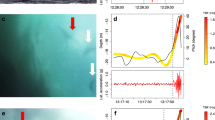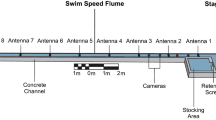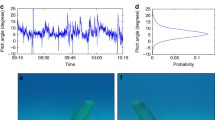Abstract
Speed of locomotion plays an important role in an animal’s biology and ecology and is of particular interest in aquatic animals. Determining cruising speeds of shark—for which such data are scarce—may help to better understand their interactions with prey, the size of the home ranges they maintain, their energetic costs and how they interact with their environment through sensory perception. In this study, the cruising speeds of a range of different shark species were measured using stereo-baited remote underwater video systems (stereo-BRUVS). The relationship between cruising speeds and fork length, species, order, habitat, trophic level, temperature and tail shape was then modelled. Fork length and species best explained the cruising speeds of the eight species of shark studied: Carcharhinus amblyrhynchos, Carcharhinus albimarginatus, Carcharhinus obscurus, Furgaleus macki, Carcharhinus obesus, Mustelus antarcticus, Heterodontus portusjacksoni and Parascyllium variolatum. This linear model had a slope that did not differ statistically from that of the theoretical model proposed by Weihs (Scale effects in animal locomotion, Academic Press, New York, pp 333–338, 1977), which suggests that the relationship between cruising speed and length appears to be dominated by energetics. The results suggest that existing allometric estimates of cruising speeds can be improved by defining cruising speeds for each species as a function of length. Currently, literature presents cruising speed data for only a few species of shark; therefore, we provide a second, generalised model, which predicts cruising speed as a function of length and tail shape. The length + tail shape model was selected based on its generality and accuracy in estimating shark cruising speeds obtained from acoustic tags. This length + tail shape model was significantly better than a length only model; it explained a further 76 % of the variation in cruising speed derived from stereo-BRUVS and acoustic tagging data than a length only model. The more accurate prediction of the length + tail shape model is most likely because tail shape is correlated with a number of ecological factors.


Similar content being viewed by others
References
Ackerman JT, Kondratieff MC, Matern SA, Cech JJ (2000) Tidal influence on spatial dynamics of leopard sharks, Triakis semifasciata, in Tomales Bay, California. Env Biol Fish 58:33–43
Autrum H (1958) Electrophysiological analysis of the visual systems in insects. Exp Cell Res 14:426
Bainbridge R (1958) The speed of swimming of fish as related to size and to the frequency and amplitude of the tail beat. J Exp Biol 35:109–133
Barnett A, Abrantes KG, Stevens JD, Bruce BD, Semmens JM (2010) Fine-scale movements of the broadnose sevengill shark and its main prey, the gummy shark. PloS one 5(12):e15464
Beamish F (1978) Swimming capacity. Academic Press
Bernal D, Dickson KA, Shadwick RE, Graham JB (2001) Review: analysis of the evolutionary convergence for high performance swimming in lamnid sharks and tunas. Comp Biochem Physiol A Mol Integr Physiol 129:695–726
Bernal D, Sepulveda C, Mathieu-Costello O, Graham J (2003) Comparative studies of high performance swimming in sharks I. Red muscle morphometrics, vascularization and ultrastructure. J Exp Biol 206:2831–2843
Blaxter KL (1989) Energy metabolism in animals and man. CUP Archive
Boyd IL, Reid K, Bevan RM (1995) Swimming speed and allocation of time during the dive cycle in Antarctic fur seals. Anim Behav 50:769–784
Bruce BD, Stevens JD, Malcolm H (2006) Movements and swimming behaviour of white sharks (Carcharodon carcharias) in Australian waters. Mar Biol 150(2):161–172
Carey FG, Kanwisher JW, Brazier O, Gabrielson G, Casey JG, Pratt HL Jr (1982) Temperature and activities of a white shark, Carcharodon carcharias. Copeia 1982(2):254–260
Carlson JK, Palmer CL, Parsons GR (1999) Oxygen consumption rate and swimming efficiency of the blacknose shark, Carcharhinus acronotus. Copeia 1999(1):34–39
Compagno LJV (1990) Alternative life-history styles of cartilaginous fishes in time and space. Env Biol Fish 28:33–75
Davidson C, Griffith C, Peters A, Fielding L (1999) Evaluation of two methods for monitoring surface cleanliness—ATP bioluminescence and traditional hygiene swabbing. Luminescence 14:33–38
Dickson KA, Graham JB (2004) Evolution and consequences of endothermy in fishes. Physiol Biochem Zool 77:998–1018
Dieringer N, Cochran SL, Precht W (1983) Differences in the central organization of gaze stabilizing reflexes between frog and turtle. J Comp Physiol 153:495–508
Dieringer N, Reichenberger I, Graf W (1992) Differences in optokinetic and vestibular ocular reflex performance in teleosts and their relationship to different life styles. Brain Behav Evol 39:289–304
Eckert M, Zeil J (2001) Toward an ecology of motion vision. In: Zanker JMZJ (ed) Motion vision: computational, neural, and ecological constraints. Springer, Berlin, pp 333–369
Ferretti F, Worm B, Britten GL, Heithaus MR, Lotze HK (2010) Patterns and ecosystem consequences of shark declines in the ocean. Ecol Lett 13:1055–1071
Fritsches KA, Brill RW, Warrant EJ (2005) Warm eyes provide superior vision in swordfishes. Curr Biol 15:55–58
Froese RaDP (2013) FishBase. www.fishbase.org
Gioanni H (1988) Stabilizing gaze reflexes in the pigeon (Columba livia). Exp Brain Res 69:567–582
Gleiss AC, Norman B, Wilson RP (2011) Moved by that sinking feeling: variable diving geometry underlies movement strategies in whale sharks. Funct Ecol 25:595–607
Graham JB, DeWar H, Lai N, Lowell WR, Arce SM (1990) Aspects of shark swimming performance determined using a large water tunnel. J Exp Biol 151(1):175–192
Grusha DS, Patterson MR (2005) Quantification of drag and lift imposed by pop-up satellite archival tags and estimation of the metabolic cost to cownose rays (Rhinoptera bonasus). Fish Bull 103:63–70
Gunn J, Stevens J, Davis T, Norman B (1999) Observations on the short-term movements and behaviour of whale sharks (Rhincodon typus) at Ningaloo Reef, Western Australia. Mar Biol 135(3):553–559
Gurshin C, Szedlmayer S (2004) Short-term survival and movements of Atlantic sharpnose sharks captured by hook-and-line in the north-east Gulf of Mexico. J Fish Biol 65(4):973–986
Hammerschlag N, Gallagher A, Lazarre D (2011) A review of shark satellite tagging studies. J Exp Mar Biol Ecol 398:1–8
Harahush BK, Hart NS, Green K, Collin SP (2009) Retinal neurogenesis and ontogenetic changes in the visual system of the brown banded bamboo shark, Chiloscyllium punctatum (Hemiscyllidae, Elasmobranchii). J Comp Neurol 513:83–97
Harris AJ (1965) Eye movements of the dogfish Squalus acanthias L. J Exp Biol 43:107–138
Harvey E, Shortis M (1996) A system for stereo-video measurement of sub-tidal organisms. Mar Technol Soc J 29:10–22
Harvey ES, Shortis MR (1998) Calibration stability of an underwater stereo-video system: implications for measurement accuracy and precision. Mar Technol Soc J 32:3–17
Hatle JD, Grimké Faragher S (1998) Slow movement increases the survivorship of a chemically defended grasshopper in predatory encounters. Oecol 115:260–267
Holland KN, Wetherbee BM, Peterson JD, Lowe CG (1993) Movements and distribution of hammerhead shark pups on their natal grounds. Copeia 1993(2):495–502
Holts D, Bedford DW (1993) Horizontal and vertical movements of the shortfin mako shark, Isurus oxyrinchus, in the Southern California Bight. Mar Freshwater Res 44(6):901–909
Huish M, Benedict C (1977) Sonic tracking of dusky sharks in Cape Frear River, North-Carolina. J Elisha Mitchell Sci Soc 93(1):21–26
Ings TC, Chittka L (2008) Speed-accuracy tradeoffs and false alarms in bee responses to cryptic predators. Curr Biol 18:1520–1524
Johnson TP, Syme DA, Jayne BC, Lauder GV, Bennett AF (1994) Modeling red muscle power output during steady and unsteady swimming in largemouth bass. Am J Physiol 267:R481–R481
Klimley AP, Beavers SC, Curtis TH, Jorgensen SJ (2002) Movements and swimming behavior of three species of sharks in La Jolla Canyon, California. Environl Biol Fishes 63(2):117–135
Kramer DL, McLaughlin RL (2001) The behavioral ecology of intermittent locomotion. Am Zool 41:137–153
Letessier TB, Meeuwig JJ, Gollock M, Groves L, Bouchet PJ, Chapuis L, Vianna GM, Kemp K, Koldewey HJ (2013) Assessing pelagic fish populations: the application of demersal video techniques to the mid-water environment. Methods Oceanogr 8:41–55
Lisney TJ, Rubene D, Rózsa J, Løvlie H, Håstad O, Ödeen A (2011) Behavioural assessment of flicker fusion frequency in chicken Gallus gallus domesticus. Vis Res 51:1324–1332
Lythgoe JN (1988) Light and vision in the aquatic environment. In: Sensory biology of aquatic animals. Springer, New York, pp 57–82
Maioli C (1988) Optokinetic nystagmus: modeling the velocity storage mechanism. J Neurosci 8:821–832
McFarland WN, Loew ER (1983) Wave produced changes in underwater light and their relations to vision. In: Noakes D, Lindquist D, Helfman G, Ward J (eds) Predators and prey in fishes. Springer, Netherlands, pp 11–22
McKibben JN, Nelson DR (1986) Patterns of movement and grouping of gray reef sharks, Carcharhinus amblyrhynchos, at Enewetak, Marshall Islands. B Mar Sci 38(1):89–110
Musyl MK et al (2001) Ability of archival tags to provide estimates of geographical position based on light intensity. In: Sibert J, Nielsen J (eds) Electronic tagging and tracking in marine fisheries. Springer, Netherlands, pp 343–367
Myers RA, Baum JK, Shepherd TD, Powers SP, Peterson CH (2007) Cascading effects of the loss of apex predatory sharks from a coastal ocean. Science 315:1846–1850
Nakamura I, Watanabe YY, Papastamatiou YP, Sato K, Meyer CG (2011) Yo-yo vertical movements suggest a foraging strategy for tiger sharks Galeocerdo cuvier. Mar Ecol Prog Ser 424:237–246
Northmore D, Dvorak C (1979) Contrast sensitivity and acuity of the goldfish. Vis Res 19:255–261
Parsons G (1990) Metabolism and swimming efficiency of the bonnethead shark Sphyrna tiburo. Mar Biol 104:363–367
Parsons G, Carlson J (1998) Physiological and behavioral responses to hypoxia in the bonnethead shark, Sphyrna tiburo: routine swimming and respiratory regulation. Fish Physiol Biochem 19:189–196
Parsons GR, Sylvester JL Jr (1992) Swimming efficiency of the white crappie, Pomoxis annularis. Copeia 1992(4):1033–1038
Peake S, McKinley RS, Scruton DA (1997) Swimming performance of various freshwater Newfoundland salmonids relative to habitat selection and fishway design. J Fish Biol 51:710–723
Puzdrowski R, Leonard R (1994) Vestibulo-oculomotor connections in an elasmobranch fish, the atlantic stingray, Dasyatis sabina. J Comp Neurol 339:587–597
Rechisky EL, Wetherbee BM (2003) Short-term movements of juvenile and neonate sandbar sharks, Carcharhinus plumbeus, on their nursery grounds in Delaware Bay. Environ Biol Fishes 68(2):113–128
Rome LC, Loughna PT, Goldspink G (1984) Muscle fiber activity in carp as a function of swimming speed and muscle temperature. Am J Physiol 247:R272–R279
Sainte-Marie B, Hargrave B (1987) Estimation of scavenger abundance and distance of attraction to bait. Mar Biol 94 (3):431–443
Salinger DH, Anderson JJ (2006) Effects of water temperature and flow on adult salmon migration swim speed and delay. T Am Fish Soc 135:188–199
Scharold J, Gruber SH (1991) Telemetered heart rate as a measure of metabolic rate in the lemon shark, Negaprion brevirostris. Copeia 1991(4):942–953
Scharold J, Lai N, Lowell W, Graham J (1988) Metabolic rate, heart rate, and tailbeat frequency during sustained swimming in the leopard shark Triakis semifasciata. J Exp Bio 48:223–230
Schieber NL, Collin SP, Hart NS (2012) Comparative retinal anatomy in four species of elasmobranch. J Morphol 273:423–440
Schnell GD, Hellack JJ (1979) Bird flight speeds in nature: optimized or a compromise? Am Nat 113:53–66
Schor CM, Levi DM (1980) Disturbances of small-field horizontal and vertical optokinetic nystagmus in amblyopia. Invest Ophthalmol Vis Sci 19:668–683
Shirai S (1996) Phylogenetic interrelationships of neoselachians (Chondrichthyes: Euselachii). Interrelat Fish 3:9–34
Souza GdS, Gomes BD, Silveira LCL (2011) Comparative neurophysiology of spatial luminance contrast sensitivity. Psychol Neurosci 4:29–48
Speakman J (1986) The optimum search speed of terrestrial predators when feeding on sedentary prey: a predictive model. J Theor Biol 122:401–407
Standen E, Lauder G (2005) Dorsal and anal fin function in bluegill sunfish Lepomis macrochirus: three-dimensional kinematics during propulsion and maneuvering. J Exp Biol 208:2753–2763
Sundström LF, Gruber SH (1998) Using speed-sensing transmitters to construct a bioenergetics model for subadult lemon sharks, Negaprion brevirostris (Poey), in the field. In: Advances in invertebrates and fish telemetry. Springer, pp 241–247
Sundström L, Gruber S (2002) Effects of capture and transmitter attachments on the swimming speed of large juvenile lemon sharks in the wild. J Fish Biol 61(3):834–838
Sundström LF, Gruber SH, Clermont SM, Correia JP, de Marignac JR, Morrissey JF, Lowrance CR, Thomassen L, Oliveira MT (2001) Review of elasmobranch behavioral studies using ultrasonic telemetry with special reference to the lemon shark, Negaprion brevirostris, around Bimini Islands, Bahamas. Environ Biol Fish 60:225–250
Syme DA, Shadwick RE (2002) Effects of longitudinal body position and swimming speed on mechanical power of deep red muscle from skipjack tuna (Katsuwonus pelamis). J Exp Biol 205:189–200
Tappeiner C, Gerber S, Enzmann V, Balmer J, Jazwinska A, Tschopp M (2012) Visual acuity and contrast sensitivity of adult zebrafish. Front Zool 9:10
Thomson KS, Simanek DE (1977) Body form and locomotion in sharks. Am Zool 17:343–354
Vásquez RA, Ebensperger LA, Bozinovic F (2002) The influence of habitat on travel speed, intermittent locomotion, and vigilance in a diurnal rodent. Behav Ecol 13:182–187
Walker JA, Westneat MW (2002) Performance limits of labriform propulsion and correlates with fin shape and motion. J Exp Biol 205:177–187
Ware DM (1978) Bioenergetics of pelagic fish: theoretical change in swimming speed and ration with body size. J Fish Res Board Can 35:220–228
Watanabe YY, Lydersen C, Fisk AT, Kovacs KM (2012) The slowest fish: swim speed and tail-beat frequency of Greenland sharks. J Exp Mar Biol Ecol 426:5–11
Weihs D (1977) Effects of size on sustained swimming speeds of aquatic organisms. In: Pedley T (ed) Scale effects in animal locomotion, Academic Press, New York pp 333–338
Weihs D, Keyes RS, Stalls DM (1981) Voluntary swimming speeds of two species of large carcharhinid sharks. Copeia 1981:219–222
Whitney NM, Pratt HL Jr, Pratt TC, Carrier JC (2010) Identifying shark mating behaviour using three-dimensional acceleration loggers. Endanger Species Res 10:71–82
Whitney NM, Papastamatiou YP, Gleiss AC, Carrier J, Musick J, Heithaus M (2012) Integrative multi-sensor tagging: emerging techniques to link elasmobranch behavior, physiology and ecology. In: Carrier J, Musick J, Heithaus M (eds) Sharks and their relatives, Second edition. CRC Press, Boca Raton, pp 265–290
Zar JH (1999) Biostatistical analysis. Pearson Education, India
Zeil J, Boeddeker N, Hemmi JM (2008) Vision and the organization of behaviour. Curr Biol 18:R320–R323
Acknowledgments
We would like to acknowledge the financial support of the Western Australia’s State Government to NSH and SPC. Collection of footage was supported by various grants including funding from Australia’s National Heritage Trust and the Zoological Society of London to JJM. LAR was supported by an Australian Postgraduate Award. JH was supported by an Australian Research Council Future Fellowship. JMM acknowledges the intellectual contribution of Robert Henry Peters (deceased) on the importance of allometry.
Author information
Authors and Affiliations
Corresponding author
Additional information
Communicated by D. Righton.
Electronic supplementary material
Below is the link to the electronic supplementary material.
Rights and permissions
About this article
Cite this article
Ryan, L.A., Meeuwig, J.J., Hemmi, J.M. et al. It is not just size that matters: shark cruising speeds are species-specific. Mar Biol 162, 1307–1318 (2015). https://doi.org/10.1007/s00227-015-2670-4
Received:
Accepted:
Published:
Issue Date:
DOI: https://doi.org/10.1007/s00227-015-2670-4




